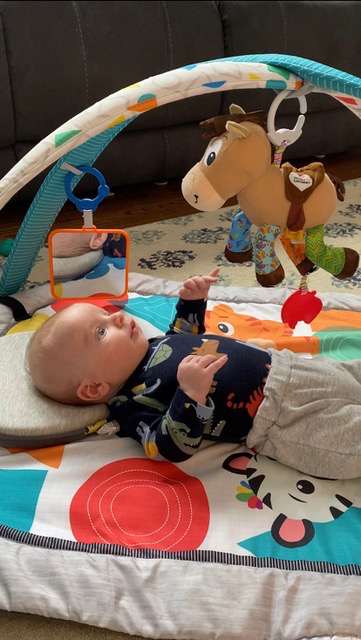Written By: Colleen Williams, PT
As therapists or teachers, we all know the importance of crossing the midline of the body. The midline is an invisible line dividing our body into a right and left half. We cross the midline of our bodies many, many times a day… when driving, cleaning, dressing, eating, chewing, writing, playing with toys, playing a sport, and more. A child typically develops the ability to cross the midline of their body visually around 3 months, then they begin reaching across their midline around 6 months. Around 8 months they cross the midline by moving an object from one hand to the other. By 4 years old, children generally can cross the midline of their body with ease.
But before you can cross the midline of your body you have to subconsciously know that you have a midline. Typically, this is achieved around 3 months as demonstrated by the midline head position when a baby is lying on their back. At 3 months, an infant transitions from asymmetry in motion and positioning to bilateral symmetrical postural control. The infant’s head is held in the middle, and they are beginning to demonstrate midline eye convergence. With their head in midline, they can move their arms and legs symmetrically and bring both hands to their body, specifically both hands to the midline of their body over their chest. A baby needs to develop a strong sense of midline as a frame of reference from which to move.
they are beginning to demonstrate midline eye convergence. With their head in midline, they can move their arms and legs symmetrically and bring both hands to their body, specifically both hands to the midline of their body over their chest. A baby needs to develop a strong sense of midline as a frame of reference from which to move.
Core stability is defined as a functional balance between the flexor and extensor muscle groups. One group is not more powerful or active than the other. One of the very first stabilizing motions of the body is the chin tuck. Chin tuck, also known as capitol flexion, is the tilting of the head and chin downward from a foundation of a stable cervical spine. This motion aligns and stabilizes the head, neck, jaw, and tongue muscles in midline. It also stabilizes the eyes in midline allowing for midline eye convergence. A chin tuck allows for the downward gaze needed for playing, eating, reading, and writing.
It is important for a baby to be able to attain a position of their head in midline when supine. You and parents can help facilitate this by doing the following when the baby is in supine or in a semi-reclined position (i.e., in a bouncy seat, propped in a bobby pillow).
- Positioning yourself in front of the baby in their “middle”
- Holding toys and picture books at midline
- Bottle feeding in the “middle”
- Work on midline eye convergence
Gain the baby’s attention and move your face close to their face. A human face, with its changing expressions, and the human voice, with its changing inflections, is more interesting than a toy can ever be. Then, move your face away from the baby. Do this a few times making sure not to fatigue the baby. Signs of fatigue may be less and less engagement, looking away, getting fussy, or crying. They won’t be having fun with this anymore!
For a baby who is having difficulty developing midline and a chin tuck:
- Position them in supine with a pillow under their head to decrease the effects of gravity and facilitate a chin tuck. Help them to play with a toy at their chest.
- Position them in side lying with a pillow under their head, hips, and knees flexed. Use a toy or pacifier and help them bring their head and mouth towards the toy.
If you are working with an older child who is having difficulty crossing the midline of their body, remember that they need to have a good frame of reference of where their midline is! Make sure that they can carry out activities at the midline with both hands in the middle of their body.
Below is an example of using a pattern stick to facilitate using both hands and both eyes together in the middle.
A pattern stick is simply a wooden dowel with different colored tape on it. You can also make a rainbow stick by using different colored pieces of tape following the ROY G BIV color sequence. Kids love them! In summary, we all need to know where our middle is before we can easily carry out activities requiring us to cross the midline.
Explore online continuing education courses from Colleen below:
Early Intervention of the Young Child

Love review of midline! Have a 2 month old Grandchild and am watching midline development. Fun and exciting! Will employ more of your suggestions. Thank You!